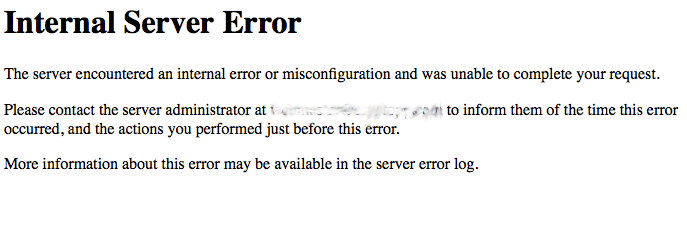A buggy website is a real headache!
And these errors on osCommerce shopping websites can be quite devastating. It even drives away your valid customers.
osCommerce internal server error usually occurs due to bad settings in .htaccess file, forbidden permissions, wrong PHP settings, etc.
At Bobcares, we often get requests to fix internal server errors as a part of our Server Management Services.
Today, let’s have a look into the error and see how our Support Engineers solve 500 errors for our customers.
A quick look at the internal server error
We’ll begin by checking on how the internal server error shows up in the osCommerce website.
osCommerce software runs on any web server that uses PHP as its programming language and MySQL as its database.
Basically, the internal server error is a server-side error. This error usually indicates that the webserver is having some trouble in serving the pages. But the server is not able to specify the exact reason.
For instance, the internal server error in osCommerce look like,

Causes for internal server error and its fix
The exact reason for the web server’s incapability to serve the osCommerce page can be different. Let’s now have a detailed look into the causes and fix for the error.
As an initial step of fixing the error, the Support Team checks for the webserver error log. For example, in Apache server, we check the logs at /usr/local/apache/logs/error_log. This gives the exact reason for the error. The common possible reasons for the error are:
- Wrong setting in .htaccess file
- Use of forbidden permissions for folder or file
- Wrong PHP settings
We will now discuss each reason in detail.
1. Wrong setting in .htaccess file
Apache servers use the .htaccess as a default file to specify rewrite rules. For the rewrite rules to work, the webserver should have mod_rewrite module support.
If we see rewrite module support missing on an Ubuntu server, we enable it by running
sudo a2enmod rewrite
And restart apache using
sudo systemctl restart apache2
Similarly, any error in the .htaccess file will result in an internal server error too. Mostly errors appear due to syntax error, typo errors, etc. in the rewrite rules.
When .htaccess contains an unsupported entry, it clearly shows up in the error log.
[Mon Aug 12 00:19:08 2014] [alert] [client 15x.xx.yy.85] /home/xxxx/domains/xxxx/public_html/.htaccess: Option All not allowed here
Therefore, when our customers approach us with 500 errors, our Support Team checks the .htaccess file and fix the rewrite rules.
2. Incorrect file or folder permissions
Similarly, incorrect file and folder permissions also result in an internal server error.
Some secure PHP handlers like suPHP do not allow certain folder and file permissions. That is, when the osCommerce folder or file has 777 permissions, it shows internal server error. Usually, the suggested folder permission is 755 and file permission is 644.
Bad permissions often report in error logs as:
[Thu Aug 29 12:37:40 2019] [crit] [client 9x.xxx.xx.228] (13)Permission denied: /home/xxx/public_html/shop/.htaccess pcfg_openfile: unable to check htaccess file, ensure it is readable
This clearly indicates that the web server cannot read the .htaccess file. Therefore, when the website reports internal server error, we switch to osCommerce directory and change folder permissions using the command:
find . -type d | xargs chmod 755
Similarly, to change the file permissions, we use the command:
find . -type f | xargs chmod 644
3. Wrong PHP settings
Syntax errors in PHP files also result in an internal server error. All variables in PHP files are case sensitive. Therefore, incorrect usage results in an error. So, when our customers approach us with this error, our Support Engineers correct the PHP configurations in the php.ini file. This makes the osCommerce website loading again.
[Still having difficulty in fixing osCommerce website?- We will fix it for you.]
Conclusion
In short, osCommerce internal server error is a server-side error that usually occurs due to bad settings in the server files. So far, we had a detailed look into the error and we saw how our Support Engineers fix it for our customers.







0 Comments